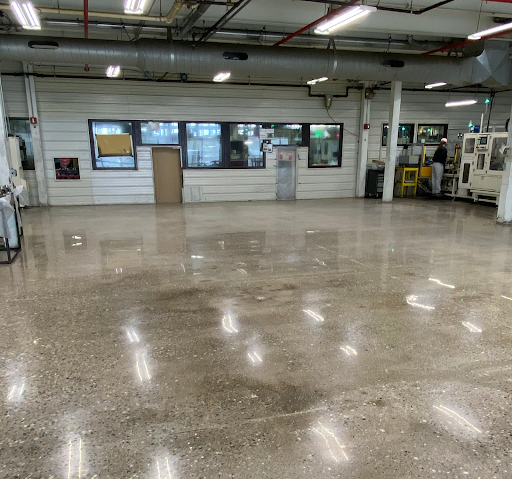The Different Types of Polished Concrete Flooring

In the past, concrete floors were only found in gritty industrial settings. But look around today and you can find concrete floors just about anywhere – from warehouses to public areas such as restaurants, retail stores, apartment buildings, and modern businesses.
With their smooth texture and high luster, polished concrete floors are an attractive and cost-effective alternative to more expensive traditional flooring options, such as resilient flooring and ceramic tile.
As concrete flooring continues to grow in popularity, learn more about the different options for commercial buildings and how the polishing process works.
What is Polished Concrete Flooring?
Polished concrete floors are a long-lasting, wear-resistant flooring system that can be used in virtually any industrial or commercial setting. A flooring professional installs a polished concrete floor by progressively grinding a concrete slab down with the use of increasingly finer diamond abrasive instruments.
In the initial stages, often referred to as the “cutting phase,” the commercial flooring installer starts by removing any imperfections present in the concrete slab while flattening and homogenizing the flooring’s surface. The length of the cutting phase is determined by the customer’s desired finish, the concrete mix, and the pour quality.
The final polishing stage, which we’ll elaborate more on below, uses fine diamond cutting tools to enhance reflectivity and luster before finalizing the installation process. Again, the number of steps involved is established by the desired finish and the various concrete flooring types.
Types of Polished Concrete Floors

A main advantage of polished concrete floors is the different types of finishes available. Each concrete flooring type is distinguished and differentiated by how much of the concrete material is removed from the primary slab.
Cream Polished Concrete
Cream polished concrete is the most affordable solution. It presents a natural modern look that is most often gray and finished off with high-gloss polish.
The downside to this option is it can only be installed on new pours. This means that you can’t take advantage of cream polished concrete on an existing floor and must be new construction. The outcome is also very dependent on the quality of both the pour and mix.
Salt and Pepper Finish
The salt and pepper polished concrete finish depends on a lightly ground slab that exposes the smallest aggregate within the original concrete mix. While it’s not unusual to encounter the salt and pepper finish in new constructions, it has proven to be a popular solution in commercial and industrial settings where an existing concrete slab already exists.
In contrast to cream-polished concrete, the salt and pepper finish is generally seen as a more luxurious, higher-end flooring application. And on the upside, this type of finish is more durable than cream-polished concrete and can be used in both renovation and new construction projects.
The primary reason customers opt against the salt and pepper finish in favor of cream-polished concrete is the higher cost.
Full or Exposed Aggregate Polished Concrete
Full or aggregate exposed concrete flooring is the result of a heavily ground surface that exposes the largest aggregate in a concrete mix. The outcome is an attractive terrazzo-like appearance at the floor level. This application is common in luxury commercial and industrial projects with high construction budgets.
While it’s technically possible to use this application on any concrete slab, it’s not suitable for all slabs. In some cases, after all the heavy grinding, the results might be underwhelming and miss the desired effect. At H&H, we recommend you sample the existing slab before fully committing to this flooring solution.
Full or aggregate exposed concrete is the most desirable of the three finishing types. It’s aesthetically appealing, highly durable, and takes well to high-gloss polishing.
Further, this finish can be used in either new constructions or the renovation of an existing improvement. The only potential drawbacks to aggregate exposed concrete flooring systems are the higher costs and longer installation times.
The Concrete Polishing Process

The professional concrete polishing process entails a heavy and consistent amount of grinding that’s broken down into multiple stages. As mentioned above, commercial flooring installers deploy consecutively finer grit abrasives to the settled concrete pour to refine its service and expose the desired amount of aggregate.
The industry refers to this abrasive process as polishing. In virtually every situation, the concrete polishing system relies on a skilled professional installer who is certified in the application. This is the only way to ensure the results turn out as expected.
In the initial stage, a commercial flooring specialist will deploy industrial-strength diamonds to remove any visible imperfections within the concrete slab. This is where the installer removes marks and scratches visible on the floor’s surface.
After, the degree and intensity of the grinding depend on the finish type and desired level of exposed aggregate. In the following steps, the certified polished cement flooring specialist will introduce a chemical agent that reacts with the concrete to harden and densify the flooring, while filling in any open pores present on the floor’s surface.
Finally, the last step is to “polish” the floor using finer diamond abrasives that give the cement slab its attractive luster and sheen. Customizing the flooring system is possible after introducing additional colors, design schemes, and stain protectants that give the floor more character and depth.
Need expert advice on polished concrete flooring installation?
Connect with an industrial and commercial flooring specialist at H&H Painting Co. for help with your upcoming concrete flooring project. Contact us now online or call us at 269-342-2465.
